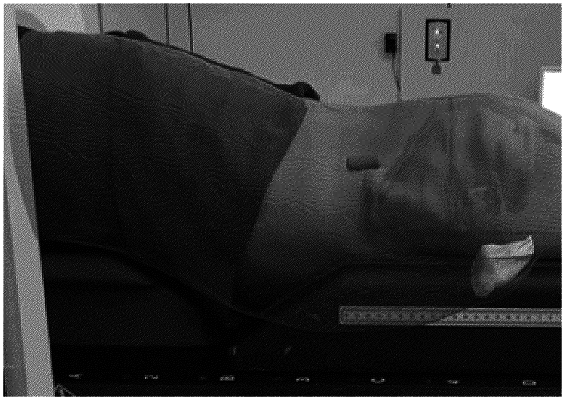| CPC A61N 5/1039 (2013.01) [A61N 5/107 (2013.01); G06T 7/75 (2017.01); G06T 13/20 (2013.01); G06T 17/00 (2013.01); G06T 19/006 (2013.01); G06T 19/20 (2013.01); G16H 20/40 (2018.01); G16H 30/20 (2018.01); A61N 2005/105 (2013.01); A61N 2005/1059 (2013.01); A61N 2005/1072 (2013.01); G06T 2207/30196 (2013.01); G06T 2210/41 (2013.01); G06T 2210/62 (2013.01); G06T 2213/08 (2013.01); G06T 2219/2004 (2013.01); G06T 2219/2016 (2013.01)] | 6 Claims |

|
1. A research and development method of augmented reality in radiotherapy, comprising the steps of: (S1) scanning an image, by a CT scanner, wherein a CT scan of a patient is performed to obtain a DICOM image;
(S2) preparing a radiotherapy plan, via a computing device, wherein the DICOM data obtained in the step (S1) are inputted into a treatment planning system, and a delineation of a planning target volume, a clinical target volume, and surrounding vital organs and tissues is carried out by a radiotherapist, and a virtual cube with the same dimensions (such as 16 cm*16 cm*16 cm) of the a cube calibration module is delineated, and the center of the virtual cube is set at the position of an isocenter of a tumor which is also situated at the isocenter of a radiotherapy accelerator, and a DICOM-RT data set is outputted;
(S3) constructing a model, by the computing device, wherein the DICOM-RT data delineated in the step (S2) are inputted into a medical image processing software to carry out a three-dimensional reconstruction, and a certain transparency in the model is used to show a contour of body surface, a planning target volume, a clinical target volume and other surrounding organs and tissues, and then a 3D model is outputted in a common 3D processing software usable format;
(S4) carrying out processing, by the computing device, wherein a 3D animation production software is used for making a material adjustment of a human 3D model, and then an augmented reality application program development software is introduced to adjust a material texture, and a light adjustment of the whole scene is made in the software;
(S5) building a system, by the computing device, wherein an augmented reality interactive system is built, and then a real-time 3D virtual model motion is driven in a three-dimensional environment to achieve an augmented reality simulation;
(S6) programming and performing an internal test, by the computing device: using a programming language to carry out functional programming in the augmented reality application development software, positioning the 3D virtual model in the system and realizing the translation and rotation of the X, Y and Z axis of the 3D virtual model, wherein a project file that is packaged and generated into a program file is tested internally in a mobile device to ensure a stable fluency of the program before use;
(S7) positioning a virtual model, by the computing device, wherein a virtual cube of the virtual model and six-dimensional alignment method of the cube calibration module are used to realize the spatial position consistency between the 3D virtual model and the linear accelerator, so as to ensure that the 3D virtual model is positioned at the isocenter position;
(S8) carrying out a clinical application via the computing device:
wherein the cube calibration module is removed, and the patient to be treated clinically lies in a treatment couch of the accelerator, and the couch is lifted, translated, and rotated according to the positioning requirement of the radiotherapy to appropriately adjust the patient's treatment body position
wherein a virtual radiation field is opened for verification and to match with the space of the early-stage 3D virtual model, so that the patient's body contour is detected by a laser radar scanner and the 3D virtual model are matched in a high degree for the treatment and
resolve non-alignment between the estimated body contour position and direction of gravity to estimate the pose sequence by an inertial measurement unit (IMU), wherein the IMU calculates a predicted position element of the image frame, and the position of the feature point at the previous moment in the next image frame to improve the matching speed of the feature selection algorithm and quick rotation algorithm.
|